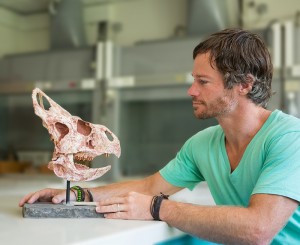In 2015, another major discovery took place, this time not of a human relative, but a new species of dinosaur.
UNE is building an established history in discovering the ancient world. Over a decade ago the university’s Anthropology discipline was put on the map when Dr Peter Brown and his colleagues in Indonesia discovered a new early human, Homo floresiensis, colloquially dubbed “the Hobbit” for its small stature.
Dr Phil Bell, from UNE’s Palaeoscience Research Centre, led the inquiry with the help of the Australian Opal Centre.

Dr Phil Bell
The yet-to-be-officially-named beast belongs to a group of large carnivorous theropods called megaraptorids. The nicknamed “Lightning Claw” – after its place of discovery, Lightning Ridge, and its giant talons – grew close to 7m in length, making it the largest discovered in Australia.
“It was obviously a predator but the key thing about this guy is the giant claws on its hands, which compensate for its dainty skull and slender jaw,” Dr Bell says.“This dinosaur probably ran down its prey and used its arms like grappling hooks.”
The find late last year is both the first major dinosaur discovery since three species were identified in Queensland seven years ago and the first substantial dinosaur remains ever from NSW.
At about 110 million years old, Lightning Claw appears to be the oldest megaraptorid known, about 12 million years older than the next found in Australia.”
Beyond that, Lightning Claw may debunk popular beliefs that dinosaurs found in Australia came from ancestors in Africa and South America.
“It is still early days, but it could be that this dinosaur originated in Australia before spreading throughout the rest of Gondwana. This specimen provides new evidence that Australia played an active role in the evolution and radiation of at least one group of apex theropods”
Dr Bell had to work with only a foot bone, parts of the hip, ribs, forearm, and a giant claw from the hand, once 25 cm long. These are relics found metres underground by seasoned miners Rob and Debbie Brogan in the 1990s.
“There were just enough clues in those bones to identify it as a megaraptorid dinosaur at least,” Dr Bell explained.
Illustration: Julius Csotonyi


